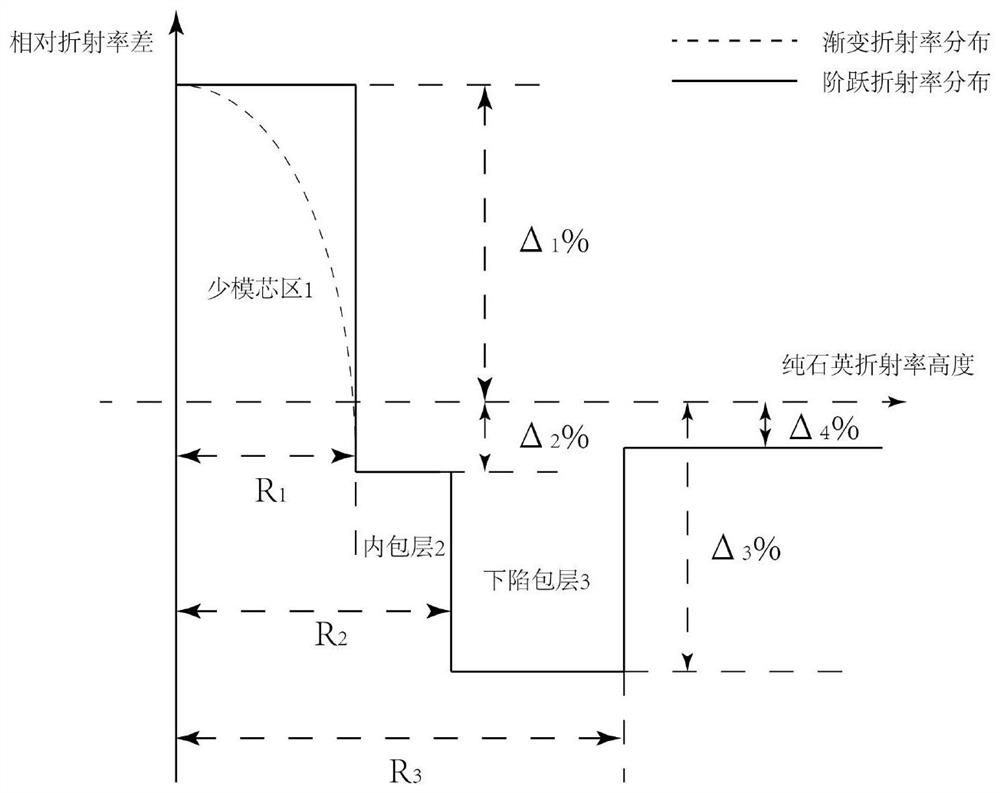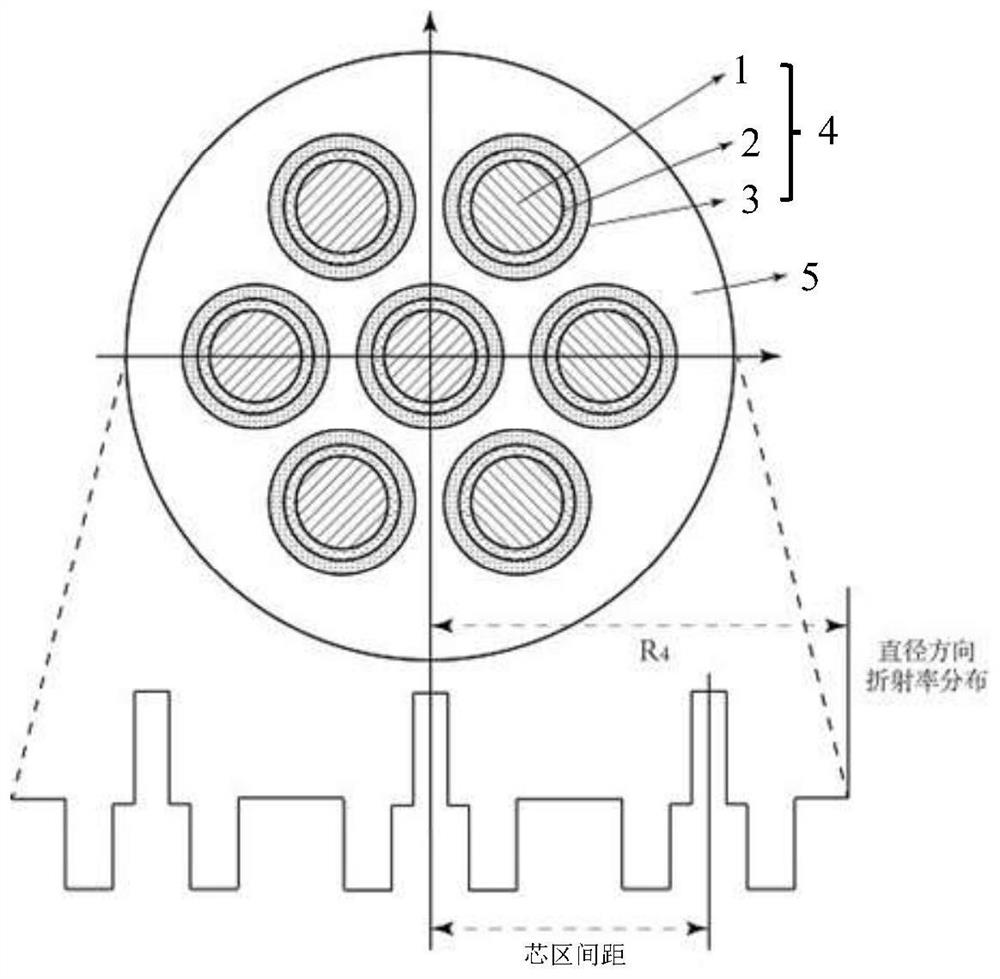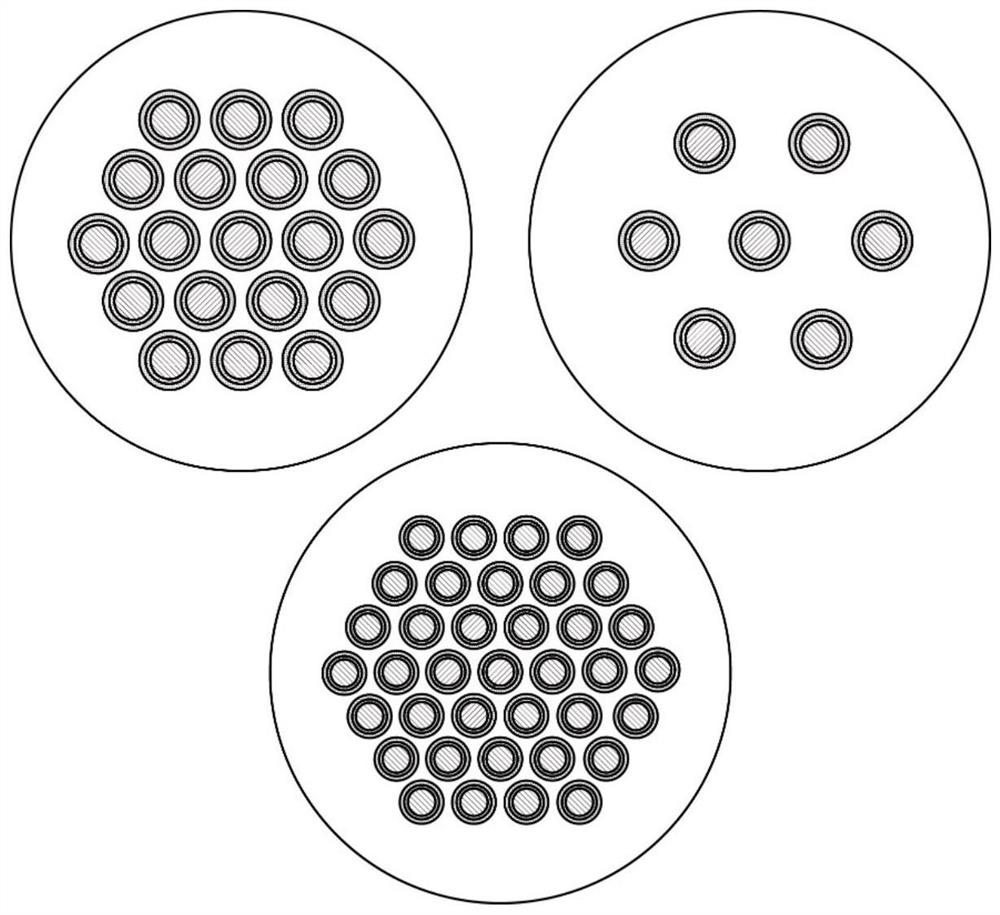A low-crosstalk weak-coupling space-division multiplexing optical fiber
A space division multiplexing and weak coupling technology, applied in clad fibers, multi-core fibers, multi-layer core/clad fibers, etc. The effect of reducing complexity and cost, increasing transmission capacity
- Summary
- Abstract
- Description
- Claims
- Application Information
AI Technical Summary
Problems solved by technology
Method used
Image
Examples
Embodiment 1
[0061] The few-mode core region 1 of the low-loss weak-coupling space-division multiplexing optical fiber provided in this embodiment is designed with a step-refractive index distribution, and is arranged in a hexagonal manner to form a seven-core optical fiber. The few-mode core region 1 uses germanium-doped quartz material, and the relative refractive index difference with pure quartz is Δ 1 0.30%. Inner cladding 2, depressed cladding 3 and multi-core fiber cladding 5 are all made of fluorine-doped silica material, where the relative refractive index difference between inner cladding 2 and pure silica is Δ 2 is -0.14%, the relative refractive index difference Δ between the depressed cladding 3 and pure quartz 3 was -0.54%. Relative refractive index difference Δ between multi-core fiber cladding 5 and pure silica 4 was -0.11%. The radius R of the few-mode core region 1 of the space division multiplexing fiber 1 is 6.7μm, the radius R of the inner cladding 2 2 is 7.9 μm,...
Embodiment 2
[0066] The few-mode core region 1 of the low-loss weak-coupling space-division multiplexing optical fiber provided in this embodiment adopts a graded refractive index distribution design, and is arranged in a hexagonal manner to form a seven-core optical fiber. The few-mode core area 1 uses germanium-doped quartz material, the power index of the refractive index gradient distribution is 1.96, and the relative refractive index difference between the maximum refractive index at the axial direction of the core area and pure quartz is Δ axial 0.50%. The inner cladding 2 is made of fluorine-doped quartz material, and the relative refractive index difference with pure quartz is Δ 2 is -0.03%. The depressed cladding 3 is made of fluorine-doped quartz material, and the relative refractive index difference with pure quartz is Δ 3 is -0.40%. The multi-core optical fiber cladding 5 uses pure silica material. The radius R of the few-mode core region 1 of the space division multiplexin...
Embodiment 3
[0071] The few-mode core region 1 of the low-loss weak-coupling space-division multiplexing optical fiber provided in this embodiment is designed with a step-refractive index distribution, and is arranged in a hexagonal manner to form a seven-core optical fiber. The few-mode core region 1 uses germanium-doped quartz material, and the relative refractive index difference with pure quartz is Δ 1 0.80%. The inner cladding 2 is made of fluorine-doped quartz material, and the relative refractive index difference with pure quartz is Δ 2 is -0.02%. The depressed cladding 3 is made of fluorine-doped quartz material, and the relative refractive index difference with pure quartz is Δ 3 was -0.51%. The multi-core optical fiber cladding 5 uses pure silica material. The radius R of the few-mode core region 1 of the space division multiplexing fiber 1 is 8.4 μm, the radius R of the inner cladding 2 2 is 9.15 μm, the radius R of the depressed cladding 3 3 is 11.75 μm. The core spacin...
PUM
 Login to View More
Login to View More Abstract
Description
Claims
Application Information
 Login to View More
Login to View More - R&D
- Intellectual Property
- Life Sciences
- Materials
- Tech Scout
- Unparalleled Data Quality
- Higher Quality Content
- 60% Fewer Hallucinations
Browse by: Latest US Patents, China's latest patents, Technical Efficacy Thesaurus, Application Domain, Technology Topic, Popular Technical Reports.
© 2025 PatSnap. All rights reserved.Legal|Privacy policy|Modern Slavery Act Transparency Statement|Sitemap|About US| Contact US: help@patsnap.com



